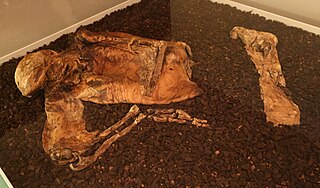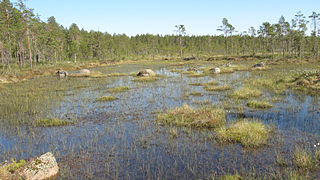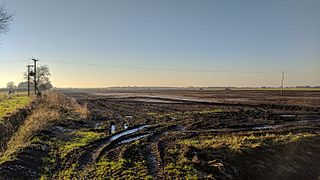Related Research Articles

Lindow Man, also known as Lindow II and as Pete Marsh, is the preserved bog body of a man discovered in a peat bog at Lindow Moss near Wilmslow in Cheshire, North West England. The remains were found on 1 August 1984 by commercial peat cutters. Lindow Man is not the only bog body to have been found in the moss; Lindow Woman was discovered the year before, and other body parts have also been recovered. The find was described as "one of the most significant archaeological discoveries of the 1980s" and caused a media sensation. It helped invigorate the study of British bog bodies, which had previously been neglected.

The Tollund Man is a naturally mummified corpse of a man who lived during the 5th century BC, during the period characterised in Scandinavia as the Pre-Roman Iron Age. He was found in 1950, preserved as a bog body, near Silkeborg on the Jutland peninsula in Denmark. The man's physical features were so well preserved that he was mistaken for a recent murder victim. Twelve years before his discovery, another bog body, Elling Woman, was found in the same bog.

The Bichon Frisé or Bichon à Poil Frisé is a Franco-Belgian breed of small toy dog of bichon type. It was recognised by the Société Centrale Canine in 1933 and by the Fédération Cynologique Internationale in 1959.

Peat is an accumulation of partially decayed vegetation or organic matter. It is unique to natural areas called peatlands, bogs, mires, moors, or muskegs. Sphagnum moss, also called peat moss, is one of the most common components in peat, although many other plants can contribute. The biological features of sphagnum mosses act to create a habitat aiding peat formation, a phenomenon termed 'habitat manipulation'. Soils consisting primarily of peat are known as histosols. Peat forms in wetland conditions, where flooding or stagnant water obstructs the flow of oxygen from the atmosphere, slowing the rate of decomposition. Peat properties such as organic matter content and saturated hydraulic conductivity can exhibit high spatial heterogeneity.

A bog body is a human cadaver that has been naturally mummified in a peat bog. Such bodies, sometimes known as bog people, are both geographically and chronologically widespread, having been dated to between 8000 BCE and the Second World War. The unifying factor of the bog bodies is that they have been found in peat and are partially preserved; however, the actual levels of preservation vary widely from perfectly preserved to mere skeletons.

A bog or bogland is a wetland that accumulates peat as a deposit of dead plant materials – often mosses, typically sphagnum moss. It is one of the four main types of wetlands. Other names for bogs include mire, mosses, quagmire, and muskeg; alkaline mires are called fens. A bayhead is another type of bog found in the forest of the Gulf Coast states in the United States. They are often covered in heath or heather shrubs rooted in the sphagnum moss and peat. The gradual accumulation of decayed plant material in a bog functions as a carbon sink.

The Fens or Fenlands in eastern England are a naturally marshy region supporting a rich ecology and numerous species. Most of the fens were drained centuries ago, resulting in a flat, dry, low-lying agricultural region supported by a system of drainage channels and man-made rivers and automated pumping stations. There have been unintended consequences to this reclamation, as the land level has continued to sink and the dykes have been built higher to protect it from flooding.

Sphagnum is a genus of approximately 380 accepted species of mosses, commonly known as sphagnum moss, also bog moss and quacker moss. Accumulations of Sphagnum can store water, since both living and dead plants can hold large quantities of water inside their cells; plants may hold 16 to 26 times as much water as their dry weight, depending on the species. The empty cells help retain water in drier conditions.
Papa Little is an island in St Magnus Bay, Shetland, Scotland.

Chat Moss is a large area of peat bog that makes up part of the City of Salford, Metropolitan Borough of Wigan and Trafford in Greater Manchester, England. It also makes up part of Metropolitan Borough of St Helens in Merseyside and Warrington in Cheshire. North of the Manchester Ship Canal and River Mersey, 5 miles (8 km) to the west of Manchester, it occupies an area of about 10.6 square miles (27.5 km2).

The Callanish IV stone circle is one of many megalithic structures around the better-known Calanais I on the west coast of the Isle of Lewis, in the Outer Hebrides, Scotland. It is a scheduled monument and its official name is Sron a'Chail. The site was first surveyed and recorded by RCAHMS in 1914 and again in 2009, with another survey in the 1970s by other archaeologists, but no known archaeological excavations have taken place at the stones.
Below are notable events in archaeology that occurred in 1951.
Tarbat Ness is headland that lies at the end of the Tarbat peninsula in Easter Ross, Scotland. The name is from the Gaelic tairbeart meaning "isthmus" and the Old Norse ness, meaning "headland". It lies at the south of the entrance to the Dornoch Firth.

Northmavine or Northmaven is a peninsula in northwest Mainland, Shetland in Scotland. The peninsula has historically formed the civil parish Northmavine. The modern Northmavine community council area has the same extent. The area of the parish is given as 204.1 km2.

Windeby I is the name given to the bog body found preserved in a peat bog near Windeby, Northern Germany, in 1952. Until recently, the body was also called the Windeby Girl, since an archaeologist believed it to be the body of a 14-year-old girl, because of its slight build. Prof. Heather Gill-Robinson, a Canadian anthropologist and pathologist, used DNA testing to show the body was actually that of a sixteen-year-old boy. The body has been radiocarbon-dated to between 41 BC and 118 AD.

Longhope railway station is a disused stone-built railway station that served the village of Longhope in Gloucestershire, England. Opened in 1855 with the line, it was located on the Great Western Railway line linking Ross-on-Wye and Gloucester. Longhope station was used in season to export locally produced jam and fruit. The station had a passing loop on what was a single track.
The Borremose bodies are three bog bodies that were found in the Borremose peat bog in Himmerland, Denmark. Recovered between 1946 and 1948, the bodies of a man and two women have been dated to the Nordic Bronze Age. In 1891, the Gundestrup cauldron was found in a nearby bog.

The Gunnister Man is the remains of a late 17th- or early 18th-century man found by two Shetlanders in a peat bog not far from the junction of the A970 road in Gunnister, Shetland, Scotland. The bog body was found on 12 May 1951 as the men were digging peat for fuel. A stone placed by the Northmavine History Group now marks the find location.
Mérine District is a district of Sidi Bel Abbès Province, Algeria. Its capital is the town of Merine.

Stoneyisland Man is the name given to a bog body discovered in the Stoneyisland Bog, Gortanumera, County Galway, Ireland on 13 May 1929.
References
- ↑ Fellows-Jensen, Gillian (2004). "Scandinavian Settlement in the British Isles and Normandy: What the Place-Names Reveal". Scandinavia and Europe 800-1350. Medieval Texts and Cultures of Northern Europe. Vol. 4. pp. 137–147. doi:10.1484/M.TCNE-EB.3.4105. ISBN 978-2-503-51085-9.